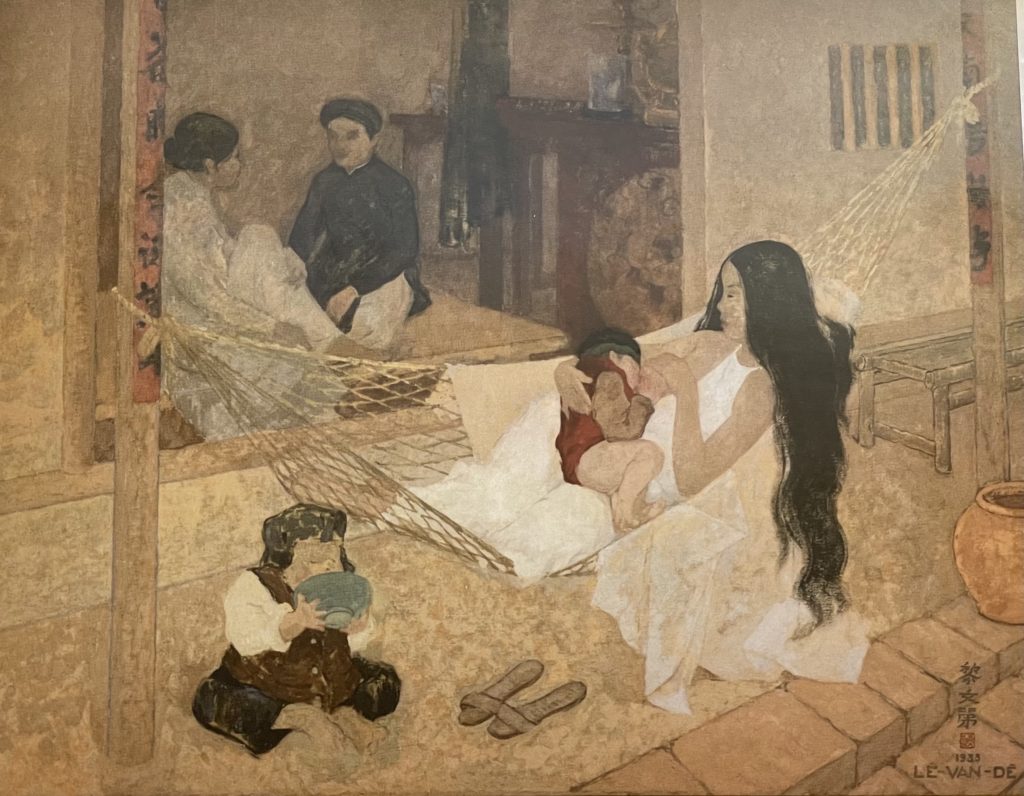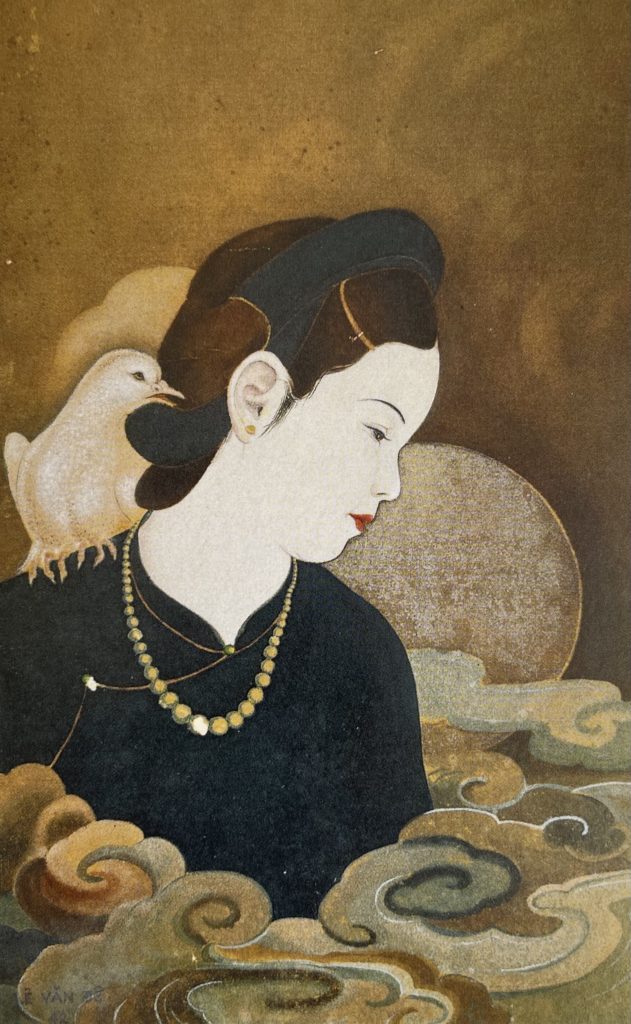Lé Van Dé, 1942, The Woman With The Dove, or the deconstruction, source of disillusionment
Lé Van Dé was born on August 28, 1906 in Mo Cay near Ben Tré in southern Vietnam. He entered the Hanoi School of Fine Arts – where the “northerners” were in majority… – in 1925. He graduated in 1930, in the first class, along with his fellow students Le Pho, Mai Thu, Nguyen Phan Chanh, Georges Khanh and Cong Van Chung. Out of the 8 who passed the entrance exam, Nguyen Tuong Lan, the future “Nhat Lin” and Le Ang Phan did drop out during their studies.
Our painter participated in the Colonial Exhibition in Paris in 1931.
In his “Report on the participation of the Indochina School of Fine Arts at the International Colonial Exhibition in Paris“, Victor Tardieu specifies Lé Van Dé’s contribution: two oil paintings, “The Red River in Hanoi” and “Boats on the Red River”; a kakemono, “The Harvest” and a layout:
« The greater part of the lacquer room, principally the three main panels composed and executed by the students LE PHO, LE VAN DE, THANG TRAN PHENH (…) the exterior entrance of the lacquer room bas-relief in staff(e) by LE VAN DE » (Victor Tardieu hand written note has been kept) :


Versatility of the School and the artist: the young Lé Van Dé, painter on canvas, engraver on wood, lacquerer and molder…
In 1930, he received a scholarship from the “Society for the Intellectual and Physical Improvement of the Indigenous People of Cochinchina”, – a southern charitable association -, to study at the Beaux-Arts in Paris as a student of Jean-Pierre Laurens (1875-1932). The latter had welcomed two years earlier Fang Ganmin (1906-1984) who returned to China to become an influential teacher (notably of Zao Wou-Ki, Chu Teh Chun and Wu Guanzhong). He was in Paris when Fang fell in love with Sue Ailan (1905-1985) whom he met at the Beaux-Arts in the Humbert studio (the only one authorized to receive female students…) and whom he would marry on his return to China.
Lé Van Dé was noticed in 1932 and 1933 during the Salon Officiel des Artistes Français (Paris) and obtained an “honorable mention”. In 1934, the French government bought from him a large canvas (179 X 225 cm) “The family interior in Tonkin” which he exhibited at the International Exhibition of Colonial Art in Naples :

He was solicited by Rome and Athens with a French government grant (6 months). Italy conquered him: in 1936 at the Vatican he was in charge of the decoration of the Asian and Australian rooms of the International Exhibition of the Catholic Press. His inclusion of the Virgin and Child on a lotus… – in front of the temple… of Angkor – was a great success.
That same year he was baptized in Rome by the man whose baptismal name he chose, “Celso” (he became Celso-Léon-Francesco, hence the C-L-F in his new signature), Monsignor Celso Constantini (1876-1958), who became a cardinal (in 1953) and devoted a large part of his life to strengthening Chinese Catholicism.
He returned to Vietnam in early 1939 as a “chargé de mission” of the French government. Mr. Nguyen Khac Nuong’s speech at the reception of Lé-Van-Dé on March 27, 1939 at the S.A.M.I.P.I.C gives us a complete summary of his life up to that point. Let us add that he was one of the founders (and president) of FARTA (Foyer de l’Art Annamite) in 1942 with To Ngoc Van, Tran Van Can, Luong Xuan Nhi, Nguyen Khang and Georges Khanh. FARTA was inspired by AFIMA (“Hoi Khai Tri Tien Duc”) founded by Pham Quynh in 1919. Its influence remains to be demonstrated but let us remember the emblem of the roof represented above the letters FARTA wanting to represent the autonomous house (finally…) where the artists could expose their works and confront their ideas. Wishful thinking if ever there was… because 1945 and its upheavals drastically changed the deal: on September 2 it is on a stage he set up on Ba Dinh Square in Hanoi that Ho Chi Minh declared the independence of Vietnam.
But let’s not jump ahead. We are in 1942. And Lé Van Dé was treated with all the honors. He has conquered the West. The French academician Louis Gillet (1876-1943) had prefaced the booklet of his exhibition held in Paris from May 13 to 25, 1938. Honored by the Vatican, distinguished by the French government, exhibited and commented on, praised, elected by his peers president of FARTA.
At 36 years old, he was almost an institution.
He then chose to compose “The Young Woman with a Dove”, a unique and atypical work. These sudden breaks in style are not unusual in Vietnamese painting. We need only think of Tô Ngoc Van in particular.
The work is much more colorful than his previous works mostly yellow-brown.

But even more so, this small (42.5 x 36 cm) gouache and ink on silk is one of Lé Van Dé’s most beautiful. The French collector who owned it assured me that the model was the own wife of the artist Georges Khanh.
This very beautiful woman displays the features of modern femininity of her time in Vietnam. Made-up eyes, plucked eyebrows, red lipstick, headdress, redesigned ao dai: all the heritage of Tu Luc Van Doan’s ideals brought to life by Nguyen Cat Tuong since the 30 ies.
The pearl necklace and the jewel in the ear shows financial ease.
She does not look at us.
The environment in which she appears is unreal.
Her bust, alone, emerges from clouds, one of which is rising in the background. A dove clutches her right shoulder.
In the background, a golden disk that could be a halo or a moon or a sun.
All decorative or symbolic elements, profane or sacred, on which one could argue. Instead,let’s us assume that Lé Van Dé delivers a decorative syncretism.
The signature is unusual with its letters without dashes and its diacritical marks. No more “C-L-F”, no more Chinese ideograms, no more stamp.
A Vietnamese painting? Secularized? De-Westernized? Di-sinized?
All at the same time.
Later, at the request of Bao Dai, he designed a stamp for Vietnam. Then, having left the communist north in 1954, he became the director of the Saigon School of Fine Arts on December 31, 1954, which was nearby the Gia Dinh’s one (created in 1913).
Lé Van Dé died in Saigon on March 16, 1966.
Fortunately, he did not have time to see his world collapse, his image erased and, finally, the failure of his career.
After 1975 and the fall of Saigon, his statue – executed by Le Thanh Non (1940-2002) in 1973 – will be removed from the courtyard of the School of Fine Arts where it was set. Worse still, and the ultimate humiliation for an artist – no doubt the painter Nguyen Do Cung, the founder of the museum, in 1966, would have been appalled – crude forgeries of his paintings were hung on the walls of the Hanoi Museum of Fine Arts. In 1968, the American Colonel James Darf was able to declare about Ben Tré: “To save the city, it was necessary to raze it” (sic).
His image hidden, his works scorned, the city of his childhood annihilated.
Everything is in this painting, a viaticum for martyrdom. It is the manifesto of an idea that will not take: the third way. Between the West and the Communists.
An absence of choice.
Because when everything makes sense, nothing makes sense anymore.
The return to his country – which Vu Cao Dam, Le Pho, Mai Thu, Le Thi Luu will not do – was a respectable quest, but to quest is not to beg.
Yes, deconstruction, if it is only demodeling, is only disillusionment.
But God, he believed, already knew it…
Jean-François Hubert
[…] Lé Van Dé, 1942, The Woman With The Dove, or the deconstruction, source of disillusionment […]